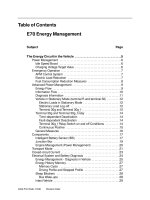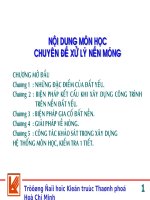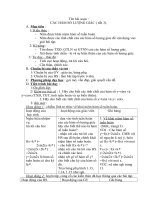D693 03
Bạn đang xem bản rút gọn của tài liệu. Xem và tải ngay bản đầy đủ của tài liệu tại đây (25.69 KB, 3 trang )
Designation: D 693 – 03
Standard Specification for
Crushed Aggregate for Macadam Pavements1
This standard is issued under the fixed designation D 693; the number immediately following the designation indicates the year of
original adoption or, in the case of revision, the year of last revision. A number in parentheses indicates the year of last reapproval. A
superscript epsilon (e) indicates an editorial change since the last revision or reapproval.
This standard has been approved for use by agencies of the Department of Defense.
Plasticity Index of Soils4
D 4791 Test Method for Flat Particles, Elongated Particles,
or Flat and Elongated Particles in Coarse Aggregate3
D 5821 Test Method for Determining the Percentage of
Fractured Particles in Coarse Aggregate3
1. Scope
1.1 This specification covers crushed aggregate suitable for
use in the construction of dry- or water-bound macadam base
courses and bituminous penetration macadam base and surface
courses of pavements.
1.2 The values stated in SI units are to be regarded as
standard. The inch-pound units, shown in parentheses, are for
information only.
1.3 The text of this standard references notes and footnotes
which provide explanatory material. These notes and footnotes
(excluding those in tables and figures) shall not be considered
as requirements of the standard.
3. Ordering Information
3.1 Orders for material under this specification shall include
the following information:
3.1.1 Name of material (Crushed Aggregate for Macadam
Construction),
3.1.2 ASTM designation (D 693 and year of issue),
3.1.3 Grading (Size Number) to be furnished (see 5.7 and
Note 2),
3.1.4 Whether to be used in base course or surface course
(see 5.1),
3.1.5 Whether for dry- or waterbound construction, or
bituminous construction (see 5.4),
3.1.6 Quantity required, and
3.1.7 Special requirements.
2. Referenced Documents
2.1 ASTM Standards:
C 29/C 29M Test Method for Bulk Density (Unit Weight)
and Voids in Aggregate2
C 88 Test Method for Soundness of Aggregates by Use of
Sodium Sulfate or Magnesium Sulfate2
C 131 Test Method for Resistance to Degradation of SmallSize Coarse Aggregate by Abrasion and Impact in the Los
Angeles Machine2
C 136 Test Method for Sieve Analysis of Fine and Coarse
Aggregates2
C 535 Test Method for Resistance to Degradation of LargeSize Coarse Aggregate by Abrasion and Impact in the Los
Angeles Machine2
D 75 Practice for Sampling Aggregates3
D 448 Classification for Sizes of Aggregate for Road and
Bridge Construction3
D 3665 Practice for Random Sampling of Construction
Materials3
D 4318 Test Method for Liquid Limit, Plastic Limit, and
4. General Characteristics
4.1 Crushed Stone or Crushed Gravel—The crushed stone
or crushed gravel shall consist of reasonably clean, tough,
durable fragments.
4.2 Crushed Slag—The crushed slag shall be air-cooled
blast-furnace slag and shall consist of fragments reasonably
clean, tough, durable, and consistent in density and quality.
4.3 Choking Material for Dry- or Water-bound Macadam
Base Courses—The choking material shall consist of natural
sand or the fine product resulting from crushing coarse
aggregate.
5. Physical Requirements
5.1 Degradation—The aggregates (with the exception of
Crushed Slag) shall conform to the following requirements:
1
This method is under the jurisdiction of ASTM Committee D04 on Road and
Paving Materials and is the direct responsibility of Subcommittee D04.50 on
Aggregate Specifications.
Current edition approved Feb. 10, 2003. Published May 2003. Originally
approved in 1942. Last previous edition approved in 1998 as D 693-98.
2
Annual Book of ASTM Standards, Vol 04.02.
3
Annual Book of ASTM Standards, Vol 04.03.
Base courses
Surface courses
50
40
Loss, Los Angeles Machine, max., %
4
Annual Book of ASTM Standards, Vol 04.08.
Copyright © ASTM International, 100 Barr Harbor Drive, PO Box C700, West Conshohocken, PA 19428-2959, United States.
1
D 693 – 03
5.2 Bulk Density of Slag—Air-cooled blast-furnace slag
coarse aggregate, when tested in size No. 57 or No. 8, shall
have a rodded bulk density not less than 1120 kg/m3(70 lb/ft3).
5.3 Crushed Pieces in Gravel—For crushed gravel, the
portion of particles retained on the 4.75 mm (No. 4) sieve, shall
have no less than 75 % two fractured faces, by mass of that
portion.
NOTE 2—See Appendix X1 for guidance in selecting aggregate sizes.
6. Methods of Sampling and Testing
6.1 Sample the aggregates and determine the properties in
accordance with the following:
6.1.1 Sampling—Practice D 75.
6.1.2 Degradation—Test Method C 131 or Test Method
C 535.
6.1.3 Bulk Density—Test Method C 29.
6.1.4 Sieve Analysis—Method C 136.
6.1.5 Soundness—Test Method C 88.
6.1.6 Liquid Limit and Plasticity Index—Test Method
D 4318.
6.1.7 Flat and Elongated Particles—Test Method D 4791.
6.1.8 Random Sampling—Practice D 3665.
6.1.9 Fractured Particles—Test Method D 5821.
NOTE 1—Some sources of gravel contain angular particles which will
perform similarly to a mechanically crushed particle. Where laboratory
tests or service records indicate this to be true, such angular particles may
be considered as crushed.
5.4 Soundness—Coarse aggregate, for dry- or water-bound
base courses, when subjected to five cycles of the soundness
test, shall have a weighted loss of not more than 20 % when
sodium sulfate is used or not more than 30 % when magnesium
sulfate is used.
5.5 Liquid Limit and Plasticity Index—The fraction of the
size No. 10 choking material (for dry- and water-bound
courses) passing the 425 µm- (No. 40-) sieve shall have a liquid
limit not greater than 30 and a plasticity index not greater than
6.
5.6 Flat and Elongated Particles—The portion retained on
the 9.5-mm (3⁄8-in.) sieve shall not contain more than 15 %, by
mass, of particles so flat and elongated that the ratio between
the maximum (length) and the minimum (thickness) dimensions exceeds 5:1.
5.7 Gradation—The aggregate gradation shall be within the
limits specified for the appropriate size in accordance with
Specification D 448.
7. Inspection
7.1 Inspection of materials shall be agreed upon between the
purchaser and the seller as part of the purchase contract.
7.2 This agreement shall provide clear definition of the size
of a lot, place of sampling and the number of samples to be
obtained to determine the acceptability of this lot.
8. Keywords
8.1 aggregate; choke aggregate; coarse aggregate; crushed
aggregate; macadam
APPENDIX
(Nonmandatory Information)
X1. Guide for Selecting Aggregate Sizes
X1.1 Aggregate size numbers are selected from Specification D 448. An appropriate size should be selected for each use,
depending on thickness of the base or the surface course, and
on other local construction and service conditions.
of surface voids in the penetration course and on the fluidity of
the bituminous binder. The following combinations of size
numbers are suggested:
Size No. of
Penetration Course
Aggregate
X1.2 For dry- or water-bound macadam base course, the
following combinations of size numbers are suggested:
Size No. of
Coarse Aggregate
Size No. of
Choke Aggregate
1, 2, or 3
10
1
2
3
Size No. of Choke Aggregate
Viscous
Fluid
Binders
Binders
5, 56, or 57
5, 56, 57 or 6
57, 6 or 7
67 or 68
67, 68 or 78
68, 78 or 8
X1.4 The size of surface course aggregate depends upon
the type of surface desired. The following sizes have been
commonly used: 7, 78, 8 and 9.
X1.3 For penetration macadam courses, the size number of
choke aggregate best suited for the work depends upon the size
ASTM International takes no position respecting the validity of any patent rights asserted in connection with any item mentioned
in this standard. Users of this standard are expressly advised that determination of the validity of any such patent rights, and the risk
of infringement of such rights, are entirely their own responsibility.
This standard is subject to revision at any time by the responsible technical committee and must be reviewed every five years and
if not revised, either reapproved or withdrawn. Your comments are invited either for revision of this standard or for additional standards
and should be addressed to ASTM International Headquarters. Your comments will receive careful consideration at a meeting of the
responsible technical committee, which you may attend. If you feel that your comments have not received a fair hearing you should
make your views known to the ASTM Committee on Standards, at the address shown below.
2
D 693 – 03
This standard is copyrighted by ASTM International, 100 Barr Harbor Drive, PO Box C700, West Conshohocken, PA 19428-2959,
United States. Individual reprints (single or multiple copies) of this standard may be obtained by contacting ASTM at the above
address or at 610-832-9585 (phone), 610-832-9555 (fax), or (e-mail); or through the ASTM website
(www.astm.org).
3





![MAKE magazine [OH] 03](https://media.store123doc.com/images/document/13/ce/fj/medium_fjg1388298702.jpg)



